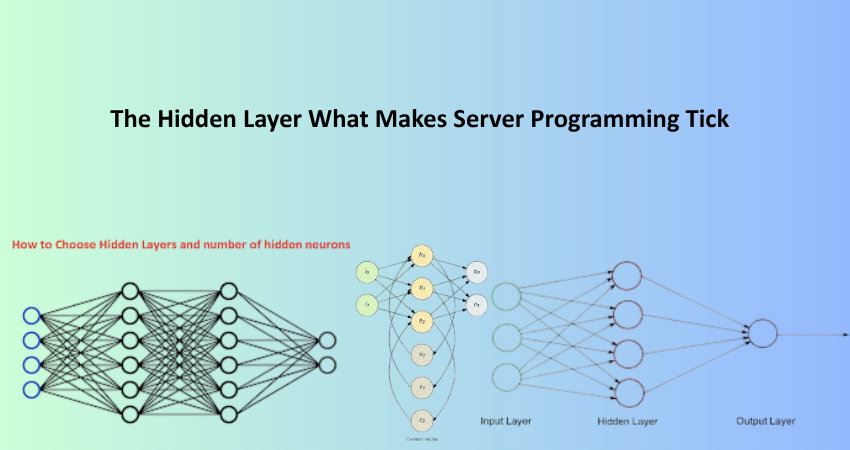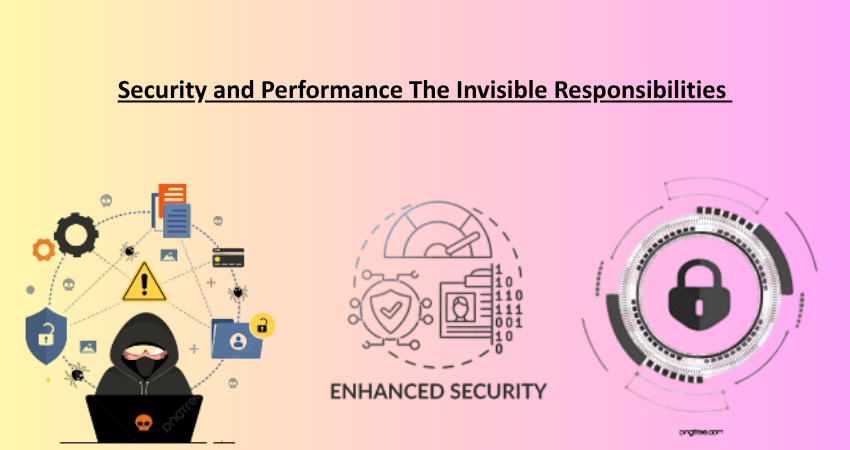
Introduction: Peering Behind the Curtain of Server-Side Logic
Anything you do on the website-watching videos, logging into applications-is all possible because of this hidden world with a gigantic system called the server. This back-end machinery works behind the scenes to store data, process logic, and deliver functionalities at your fingertips. While front-end development is all about what the users see and interact with, it is back-end programming where the real magic glows; the unsung hero that makes modern web experience possible.
Server programming, otherwise called back-end development, is building the logic and the infrastructure, which allow applications to function, scale, and secure the data it deals with. Server programming also includes writing the codes that handle requests, authenticate users, connect with databases, process data, and return responses for the front-end. The web and mobile applications are getting ever more complex, which means that the server is going to become even more vital. This isn’t knowledge just for engineers-it’s essential for every tech-savvy professional. In this article, we will first look at how server programming works, then what components power it, and finally, the skills and technologies that make it tick.
Server Architecture: The Blueprint of Back-End Systems
Monolithic vs Microservices Architecture
Server programming involves architecture, which determines the arrangements of the software components and the manner of their interactions. Traditionally, applications were based on a monolithic model. A single code base was assumed to hold all the application logic, business logic, and the user interface logic; deployment became a simple process. But that meant that getting any part of the application scaled or updated meant having to touch every single part of the application. Monolithic systems start off easy, but with the growth of the application, they are very much cluttered and, therefore, hard to maintain.
The microservices paradigm, on the other hand, allows for the splitting of an application into several smaller services. Each small independent unit is to perform a very specific function. For an example, for an e-commerce application, we may have independent services for user management, inventory, checkout, and recommendation. These services typically communicate through API calls, and each service can evolve, deploy, and scale independently. This brings a lot of flexibility, robustness, and scalability to the architecture but also increases the complexity level, especially in terms of orchestration, monitoring, and deployment. And, thus, comprehension of these architectural paradigms goes a long way in helping the modern server developer to build systems that scale effectively with change.
Stateful vs Stateless Servers
An essential architectural paradigm in server programming is namely, the difference between stateful server and stateless server. A stateful server keeps track of client requests. This is useful in session management or in the long run in server-based interactions. However, this makes dependencies which complicate the scaling up and reliability of services. For instance, if a server keeps session data in memory, if the server crashes, the session is lost.
The stateful servers have requests as independent requests having all the information to process them: That is where stateless benefits people love to enjoy cloud-native applications or RESTful APIs. In fact, they can be easily aggregated and flavored with load balancing. The sideways scales and high availability but requires a careful approach to sessions and mostly through tokens, or sometimes by placing a need or obligation before retrieval by data store.
Programming Languages and Frameworks: Tools of the Trade

Popular Server-Side Languages and Their Strengths
However, each of these languages is going to have its own special strengths, ecosystems, and community supports that back it. JavaScript just blew up because of Node.js, which has a non-blocking I/O model where the same language is used on both the client and on the server side. It doesn’t use up that much space and makes things much easier with concurrent requests. Real-time applications such as chat applications and streaming media make use of this kind of efficiency.
Moreover, Python is likable because of the many frameworks such as Django and Flask, especially for readable code and rapid development. More often, it is being used for data-centered applications, machine learning applications, and scientific computations. Java, nonetheless, is still very much present in Enterprise because of its stability, performance, and a strong ecosystem. PHP is said to be better than most of the content management systems today, like WordPress, but still counts among the null and void with which it is harshly criticized. Ruby and Rails place much more emphasis on convention than configuration, so are excellent for very fast-starting startups. Although more recent, Go and Rust are quickly becoming the trends because of performance and safety. Language, after all, depends on the application needs, performance needs, and capabilities of the team.
Frameworks That Power Back-End Development
West of the mainstream are frameworks, helping developers to efficiently build robust server applications. Such frameworks offer a plethora of pre-built components, design patterns, and libraries that lessen cumbersome boilerplate code and maximize productivity. For example, Express.js has become the de facto standard for Node.js applications because it is lightweight, sufficiently fast, and gives enough flexibility to developers to use minimal configurations in building their APIs and web applications.
Django (Python) is somewhat of a “batteries-included” framework inasmuch as it gives an admin panel, ORM, authentication, etc., out of the box, which is great for developers who prefer a fully featured toolkit. Flask is a minimalistic approach for lightweight apps. Java framework Spring Boot allows developers to build production-ready apps with embedded server support, microservices support, and advanced security features. Laravel (PHP) brings elegant syntax and many built-in features such as migrations, templating, and authentication. Knowing a framework saves valuable time, but it also gives one assurance that his server-side applications will be secure, maintainable, and scalable right from day one.
Data Management: The Heartbeat of Server-Side Logic
Database Systems: SQL vs NoSQL
The fundamental job of a server is data storing; the usefulness of a database comes from that. Thus, the structured manner of storing and retrieving information in the best manner, and the management of those info, can be efficiently done with a database. Therefore, most databases are classified into two groups-SQL (relational databases) and NoSQL (nonrelational databases). Examples of SQL databases include MySQL, PostgreSQL and SQL Server-with structured schema and flexible query capability-flowed by the Structured Query Language (SQL). These databases are good for applications that require knowledge of complex relationships, consistency and transactional integrity-financial systems or inventory management platforms, say.
Somehow, there are databases that are in the NoSQL classification; they include MongoDB, Cassandra or Firebase, all of which can cope with very flexible unstructured and semi-structured data. NoSQL databases mainly focus on scalability and speed; hence, they are just right for real-time analytics, social media platforms, and IoT applications. NoSQL systems typically do not enforce rigid schemas so design changes can be made quickly, allowing for a variety of data types to be accommodated, unlike SQL. Knowing what to use, where to use, and sometimes how to combine the two will make the designing of server-side applications robust and future-sustainable.
ORMs and Query Builders
This SQL is quite powerful but most certainly inconsistent across different database systems and full of errors. The ORM and query builders thus remain the darling of server developers. ORM, like Sequelize (Node.js), SQLAlchemy (Python), or Hibernate (Java), allows the developer to work with the database using the programming language they are using. This improves productivity, promulgates best practices, and provides easy maintenance.
Then come query builders like Knex.js and Eloquent (Laravel) which cover the middle ground-between ORM and raw SQL. They provide a blend of performance and structure of queries for readability and safety of code. These types of tools manage and facilitate the migration of databases and maintain schema consistency. Such tools manage and facilitate the migration of databases and maintain schema consistency. They can all block the most common threats such as SQL injections. Testing and abstraction benefit further from shielding low-level details of database implementations so that changing database systems requires the modification of only the slightest pieces of code. A very well controlled use of the ORM and query builders can therefore increase the development cycle greatly with pure logic and safe server-side processing.
Security and Performance: The Invisible Responsibilities

Authentication, Authorization, and Data Protection
One of the main concerns in server programming is security. The server is seen as the entrance for various sensitive data; hence, it needs to be secured against several threats. Authentication and authorization are the basic concerns. Developers opt for password hashing, two-factor authentication, OAuth2, and JSON Web Tokens (JWT) to ensure safe access to applications. A badly implemented authentication system opens user data to being exposed and brings compliance nightmares.
Data encryption in motion and at rest is another major consideration. Other essential methods include input validation, output encoding, and rate limiting to secure the application against all kinds of attacks, from injection and cross-site to denial of service. Server developers should also ensure they comply with regulations like GDPR and HIPAA in their data practices. Clearly, security is not a one-time thing-it’s rather an ongoing process embedded in the development lifecycle.
Caching, Load Balancing, and Performance Optimization
Performance manipulation has no less importance in the server programming arena. What every user would want is fast responding applications, while any time lag at the server end is likely to cause frustration or counter them. One of the most powerful techniques focused on enhancing performance through cache would be the temporary storage of frequently accessed data in the memory using a cache tool such as Redis or Memcached. It reduces a number of loads from the database, thus reducing server-response time, as well as improved infrastructure cost.
The next concept is load balancing which lies at the core: that is the aspect of distributing into many servers the incoming traffic in order to prevent one from becoming overloaded and guarantee high availability. Load balancers can be look like NGINX, HAProxy, or even load balancers as cloud services that are capable of intelligently routing requests to the best performing instances. Additional functions of asynchronous operations, connection pooling, and algorithm efficiency towards optimizing server response time will greatly increase user experiences. Furthermore, support systems such as profiling tools, logging systems, or performance-monitoring dashboards such as New Relic or Datadog are extremely helpful at recognizing the bottlenecks and guiding improvement efforts. Ultimately, performance optimization is all about sport-fast and sturdy server groundwork that scales along with application growth.
DevOps and Deployment: Taking Code Live
CI/CD Pipelines and Automation
A server program has a life that begins and ends beyond writing the code. Building, testing, and reliably deploying the program into production is what it means, and that’s where CI/CD pipeline comes in-to automate processes. Developers who run GitHub Actions, Jenkins, Travis CI, or GitLab CI automatically have applications tested, linted, and deployed to production whenever a new code is pushed onto their repository. Human error is reduced; time to market accelerates, and it really cheers to deploy frequently.
CI/CD also encourages collaboration through integrating code reviews, static analysis, and environment setups without interruption. Configuration management tools like Ansible, Chef, or Terraform would keep staging, development, and production environments in sync. Learning how to interface with CI/CD pipelines is therefore invaluable for server-side developers to gain instant and safer delivery of upgrades. Server programming becomes, thus, a much-modernized linchpin of software engineering rather than just a unique skill.
Containers, Virtualization, and Cloud Hosting
Container and virtualization have become the finest technologies for server deployment today. Docker has brought about a paradigm shift in the way applications are packaged and run. Docker allows developers to package their software with all of its dependencies into one or more lightweight containers. Kubernetes takes it one step further to deploy, scale, and manage containerized applications across clusters of machines.
Though virtual machines are heavier than containers, they still provide an extra level of isolation and security. These cloud platforms offer a plethora of services-all geared towards hosting, scalability, and back-end infrastructure management-such as AWS, Azure, and Google Cloud. There have been some emerging trends in serverless computing, which allows for the cost-efficient and simple execution of functions on demand without worrying about servers. An understanding of the deployment landscape is important to server programmers as they strive to ensure that their code runs well not only locally but also in a production environment halfway across the globe.
Conclusion: The Engine Room of the Digital World
One of the main elements of almost every type of modern digital exposure is server programming, and almost nobody knows anything about it. It covers a huge span from architecture and database management to security, performance, and deployment-all of which require much more than just writing code and become an in-depth knowledge of how real digital applications operate and scale. Server programming is incredibly complicated, challenging, and deeply fulfilling for a select few who can make it through.
As businesses are inclined to be more dependent on solid, real-time, and safe digital infrastructure, server-side skills are never going out of date and will continue to be one of the future winners. For a budding developer or experienced engineer to get into the depth of really fulfilling software, you take them down this hidden layer: logic vs. performance, where innovations really happen at quite critical-but still behind-the-scenes.